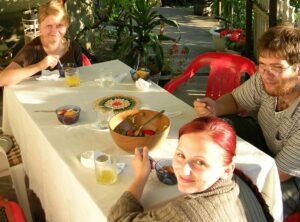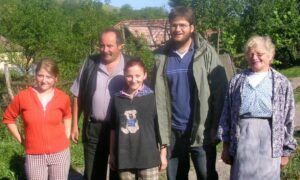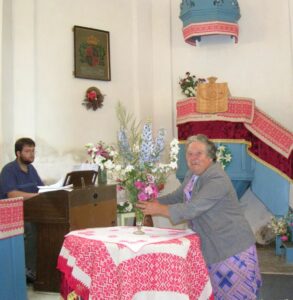A Visit to Our Partner Church in Iszlo, Romania
by Lynda Hambourger
The UUA (Unitarian Universalist Association) began establishing partnerships with Unitarian churches in Romania in the early 1990s, after the fall of the communist Ceaușescu regime. For all Romanians, this was a difficult, transitional time from a state-run economy to a capitalist economy, and especially for the Hungarian-speaking minority in western Romania, an area historically known as Transylvania. Unitarianism had been started in Transylvania in the sixteenth century by the religious reformer Francis David (1510-1579). The faith still continues there, often in small villages inhabited by Hungarian speakers. Though there had been contacts between Transylvanian Unitarians and American Unitarians in the late 19th and early 20th centuries, these were disrupted during the communist era in eastern Europe.

Blanca, Eva and Tim eat outdoors in our hosts’ backyard
In 1990, UUFR’s minister Morris Hudgins and Jim and Jane Hunt initiated the process of pairing UUFR with a small Unitarian church in Iszlo, Romania. In 1992, two UUFR members, Linda Johnston and Lyle Estill, visited Iszlo, managing to smuggle in money donated by UUFR and other UU churches in support of three small churches, including the Iszlo church, pastored by Rev. Sandor Varga. During the 1990s, the relationship was strengthened by visits Sandor and Morris exchanged to Raleigh and Iszlo; later visits included members of both of their families and other members of UUFR. In summer 2001, UUFR’s Rev. Julie Denny Hughes, Joyce Dunn, Jim and Jane Hunt, Gary Jarvela, Cathy Murphy and Leta Thornton journeyed together to Hungary, Czechoslovakia and Romania to visit our partner church, meet the village residents and tour the land where Unitarian roots were established more than 400 years earlier.
In June 2005, my son Timothy (then age 18) and I paid a visit to UUFR’s partner church in Iszlo. We spent time in Bucharest, Romania (and later in Budapest, Hungary) before meeting up with four people from Eliot Unitarian Chapel, located in Kirkwood, MO, for the Partner Church part of our trip; Eliot Chapel was the partner of one of Sandor Varga’s other churches. Below are some excerpts from my journal during our trip.

Blanca, Attila, Eva, Tim and the girls’ grandmother
Saturday, June 18. We travel to the beautiful little city of Marosvasarhely which is the hometown of our guides, sisters Csilla and Magda, and our driver, Istvan. We see the cultural palace, where there are gorgeous art nouveau stained glass windows, and we step in the auditorium to see the Hungarian Alliance party in session. We eat lunch, shop and stroll, then drive to Narad St. Marton, where Sandor Varga and his wife Edit and daughter Viola live. They are expecting us at 5 p.m, and we must time our arrival to be neither late nor early. We pull up just on time. Children give us bouquets, a youngster with a funny, frizzy hairstyle (I later learn she has undergone treatment for leukemia) recites a poem, and we are ushered into the parish house, where we are treated to donuts, cakes, wine, juice and palinka. Sandor is excited and ebullient. A middle-aged woman regales us with humorous stories. Everyone is in good spirits and has a good time. Atilla and Blanka, two of our host family members, arrive to pick up Tim and me. By 7 p.m., we are in Iszlo. The house is comfortable, but somewhat odd to my American eyes. Just one bathroom, and the water is heated by wood. Pullout sofa beds for Tim and me, heavy comforters, even in summer. But we each have our own room and private use of the bathroom. Blanca (age 20) and her sister Eva (21) are both finishing their third year of college. They live in Marosvasarhely, where their college is, during the term and come home to Iszlo for the summer and holidays. They are bright and lively—Blanca blond and blue-eyed, Eva dyed red hair and green eyes. Both speak English very well. When in Iszlo, they live with their mother Kati and her boyfriend Atilla. Their older sister, also Kati, is deaf, and lives with them in Marosvasarhely and works as a seamstress.
For dinner Kati serves liver and I (as the only meat-eating guest, Tim being a vegan) feel obliged to show appreciation for the hospitality by eating some. But she serves me three slices! I manage to down a half slice. After dinner the girls and Tim and I have a nice conversation about school, the differences between Romania and the U.S. We take a walk over the fields, see their elementary school, a graveyard, the woods, and a beautiful sunset.
Sunday, June 19. We sleep late—almost till 10! We needed the rest. We have a late breakfast. Sandor has a busy schedule, with an early service at his church at Brgahaze, followed by an 11 o’clock service at St. Marton’s, then a funeral, then the service at Iszlo at 2:30. We attend only the Iszlo service; Sandor does a nice service, with a text from the New Testament book of Timothy, in Tim’s honor. Tim plays a piece on the organ. Imre, the organist/cantor, plays the hymns—very slowly—and accompanies a young woman, Erika, who sings in English two songs especially prepared for us: We Shall Overcome and Mother Spirit, Father Spirit. Not many people are in the church; about 20 men (sitting on the left side) and fewer women and some children on the right side. After church we all gather outside for photos and handshakes. Unfortunately, we were late to the service, so I have not brought my gifts for the children (gum and pencils). The church is on top of a steep hill with no road or walkway, so it is hard for old people to get to church; it wasn’t an easy climb for me either!
After church, we all go back to Kati’s for Sunday dinner. There is wonderful cherry soup, lots of bread and sweets, goose, lamb, pork, peas and carrots, etc., etc. And of course plenty to drink. The four people from Eliot Chapel and Csilla are there. There’s much toasting, conversation, jokes. Sandor calls for some singing. I sing Spirit of Life and, with Erika, Mother Spirit, Father Spirit. Tim talks to Imre about being a musician. Afterwards, Tim and I take a walk though the village while our host family cleans up—they have a big job!

Tim at the organ and church bellringer Margaret arranging flowers inside the Iszlo Unitarian church
Monday, June 20. Kati is leaving—going to Bistrita to complete a short work-related course–she is some kind of agricultural engineer; Attila has a similar position. Since their English is not good and Blanca and Eva (who translate) don’t seem to understand the details, we never quite figure out what their jobs are, perhaps some kind of extension agent. We go to Narad St. Marton where we meet the rest of our group and our van. We take a tour of Unitarian churches in the area.
After we get back from our trip, we spend some time relaxing with Blanca and Eva. They cook us a traditional dish—cornmeal with sheep’s milk cheese—and salad for supper. Delicious. I write out a statement of the money UUFR is giving to Iszlo. After dinner, at 8:30, we have our church meeting. I present the money to Sandor and the lay president of the Iszlo church. I also give them a picture book of North Carolina and the pencils and other things for the children. We toast with palinka and eat donuts. I say how much I appreciate knowing Unitarians in this part of the world—this is holy ground for Unitarians—where the faith is 450 years old. After about an hour, most of the men leave, many kissing my hand as they do. The meeting has mostly been men. Only four women—Blanca and Eva, who translated, their grandmother, and Margaret, the church’s bellringer. And me, of course.
Tuesday, June 21. A day trip to Biertan church and Segisvar. Biertan is an old sandstone German-Saxon church on a hill. It is a fortress church, used for protection as much as worship. One room of the church was used as the treasury. It has the most complicated, ingenious lock system; though built centuries earlier, the whole door and lock system were removed to take to Paris for the exposition of 1900 where it was exhibited and won a prize. The front door of the church also has an ingenious double lock, which a single key can open, but only if the key is turned upside down halfway through the unlocking operation. The German-Saxons were very concerned about security! Segisvar is one of very few remaining inhabited medieval walled cities. Again, it is German-Saxon. The town has a clever clock in a large clock tower, with figures on both sides. A beautiful church, and many quaint homes and shops. After sightseeing, we drive back to Narad St. Marton. We wait a bit for our farewell dinner—which consists of stuffed cabbage. There’s lots of talking and toasting.
Wednesday, June 22. Last morning in Iszlo. We say goodbye to Attila, Eva and Blanca and exchange gifts. Attila drives us to St. Marton, where we say goodbye to Sandor and Edit. From there we head for our train to Budapest.
UUFR’s partner church relationship with Iszlo lasted for about another 10 years. Sandor and Edit visited Raleigh again in April 2010, a visit that had to be extended because of ash from a volcano in Iceland which limited travel back to Europe. However, the relationship waned after Sandor’s retirement, and in 2021 the UUA discontinued the partnership program in Romania.
Many UUFR members visited our partner church in Iszlo. Share your stories and photos of Iszlo or another memory of a particular community or social action project supported by UUFR. Send stories and photos to